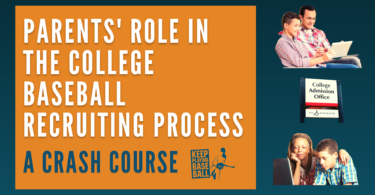Note: The D1 Council has voted to grant D1 players who transferred for the first time during the spring/summer of 2020 immediate eligibility for the 2021 with a blanket waiver.
Are you a college baseball player thinking about transferring to a new program? If so, you’ve come to the right place.
We always have people asking about the details of transferring. Transferring is not something that should be done casually. Part of playing college ball is bonding with your teammates. Transferring can be tough, because it means you’re leaving a lot behind – players, coaches, program, and, most importantly, friends.
That being said, we know that there are good reasons to transfer and that transferring is a big part of college baseball (especially as COVID-19 has complicated things to an extreme). As what would have been this season inches towards an end, the transferring cycle has already kicked into high gear. Some players use transferring as a means to an end. Transferring from a JC to a D1 or D2 program is a common goal for a lot of guys, and a great way for players to work towards roster spots at 4-year schools if they aren’t ready out of high school. 1 out of 5 D1 players are JC transfers. Sometimes players find out, after they’ve spent a year at a school, that the program is not the right fit – athletically, academically, or both. Now, many players are transferring because crowded rosters or loss of scholarship money for their final season. It is possible to transfer out of any NCAA or NAIA school and play in another school BUT there are a lot of rules that must be followed and those rules differ depending on what programs and divisions are involved in the move.
What does that mean for you? That means you need to follow all the rules very carefully (even as they seem to be changing frequently), so that you don’t lose any of your options or eligibility. There’s more to transferring than simply switching jerseys, and the course schedule you have taken will be very important for fulfilling academic transfer requirements. If your transfer involves an NCAA school, your first step should be to go to the NCAA Transfer page HERE and follow the steps listed. For NAIA schools, you can find information in their guide. But these guides will only give you part of the story. You’ll need to get information directly from officials in the athletic and admissions departments in both schools.
Here are some examples of transfer rules.
- If you are at a D1 school, most of the time you cannot transfer directly to another D1 and play immediately. However, new legislation that went into effect August 1, 2019 will create some additional exceptions that allow players to transfer D1 to D1 and play right away. Here are the exceptions: 1) Freshman players enrolled in summer school ahead of their first full school year may transfer without penalty if the head coach leaves the program prior to the 1st day of the fall classes. 2) Non-scholarship walk-on players may transfer to another D1 school and play immediately. 3) Players who have completed their undergraduate degree with additional eligibility may transfer to another D1 program for graduate school and play immediately. The new rules also state that you cannot compete in an athletic contest for more than 1 school in the same school year (an important thing to note for players who play multiple sports).
- Most of the time, you can transfer from a D1 school to other levels (D2, D3, NAIA, etc.) and play immediately.
- Most of the time, if you transfer from a 4-year school to a 4-year school in a higher division, you have to sit out a year.
- In almost every case, you can transfer from a 4-year school to a 2-year JC and play immediately.
- If you transfer from a 2-year JC to a 4-year school, your grades and credits are EXTREMELY important. Read our article on transferring from a 2-year JC to a 4-year school HERE for information on academic transfer requirements. Transferring from a 2-year JC to a 4-year program is much easier when you show up with a plan from day 1.
But, individual conferences or divisions may have their own rules. You need to do your homework, especially as rules are changing due to COVID-19 adjustments on a regular basis!
Here are a few other things to consider before deciding to transfer.
The first is academics. Do not underestimate the importance of education. Consider that very, very seriously when you’re thinking about changing schools. Remember, the percentage of players who get into pro-baseball is very small. Make sure that you are not giving up anything that you might regret later.
If you’re thinking about transferring because of playing time, take a good long look at the roster at your current school. Check out when the guys in front of you are graduating and who you are competing with. Have a very honest conversation with the coaches at your current program about earning playing time moving forward or even if it would benefit you to play another position. Explore all your options before you look to move elsewhere.
If you got cut, evaluate the roster for next year. Remember, if you’re cut, it counts as a red-shirt year, so you don’t lose a year of eligibility. Have you spoken with the coaches about future opportunities? Will your current team graduate a lot of seniors? Did players who played your position after you got cut under-perform? Have they put themselves in a position where your spot will be open?
There can be a lot of complicated feelings when you get cut. Some guys take offense. Players who are competing to play in college have probably never been told they’re “not good enough.” Sometimes coaches make mistakes and cut the wrong guys. It happens. But it doesn’t happen that often. Make sure you take an objective look at your performance. Keep in mind, it’s a recruiting coordinator’s job to make sure that the best possible players come into his program, so that the coaching staff has the best options to build their roster from. Whatever you were told, without an athletic scholarship, there aren’t any guarantees for a roster spot. Period.
If you get cut, your first reaction should not be to leave. One of the best hitters I ever played with in college was cut his freshman year. During that season, he worked harder than anyone on the roster. He hit late at night, lifted consistently, and took every opportunity to improve his skills. Not only did he get better as a ball player, but he earned the respect of everyone on the team. He made the team his redshirt-freshman year, and was a Freshman All-American. The ability to earn your way back on the team will not be an option everywhere, but an honest conversation with the head coach can go a long way in determining future outlook for getting back on the team.
There are a lot of reasons that people consider transferring. Some of those reasons are good, others are not. It can’t be a gut decision. You need to use your head and be objective. Make sure that you talk it over with your family and your current coaching staff before you make a decision. These might not be pleasant conversations, but they’re absolutely necessary. You never know what information you’ll learn and what promises will be made. If you do decide to transfer, make sure you understand what it will mean in terms of your eligibility to play and practice. Take your time and make the right decision that will make you happy on and off the field.







